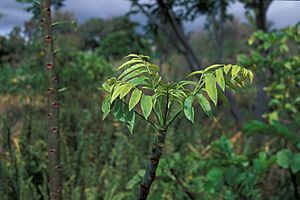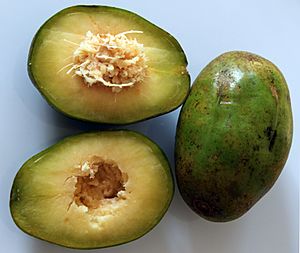Spondias dulcis facts for kids
Quick facts for kids Spondias dulcis |
|
|---|---|
 |
|
| Scientific classification | |
| Genus: |
Spondias
|
| Species: |
dulcis
|
The Ambarella (also called Spondias dulcis or June Plum) is a tropical tree. It grows in warm, sunny places near the Earth's equator. This tree produces a tasty fruit. The fruit has a hard, fibrous pit inside. People in places like Sri Lanka often call it Ambarella.
Contents
About the Ambarella Tree
The Ambarella tree grows quickly. In its natural home, like the islands of Melanesia and Polynesia, it can reach up to 20 meters (about 65 feet) tall. In other places, it usually grows to be 10 to 12 meters (about 33 to 39 feet) tall.
Leaves and Flowers
The Ambarella tree has leaves that fall off each year. These leaves are long, from 20 to 60 centimeters (about 8 to 24 inches). Each leaf is made up of 9 to 25 smaller, shiny leaflets. These small leaflets are about 9 to 10 centimeters (about 3.5 to 4 inches) long. They have tiny teeth along their edges near the tip. The tree also grows small, white flowers. These flowers are not very noticeable. They grow in clusters at the ends of the branches.
The Fruit
The fruit of the Ambarella tree is oval-shaped. Each fruit is about 6 to 9 centimeters (about 2.4 to 3.5 inches) long. They grow in bunches of 12 or more on a long stem. The fruits fall to the ground when they are still green and hard. As they ripen, they turn a golden-yellow color. Some fruits in the South Sea Islands can weigh over 500 grams (about 1 pound).
Where Ambarella Grows
The Ambarella tree has been planted in many tropical areas around the world. It was first brought to Jamaica in 1782. Today, you can find it growing in countries like Panama, Cuba, Haiti, and Puerto Rico. It also grows in Trinidad and Tobago, and St. Lucia.
The United States Department of Agriculture tried to grow it in the US in 1909. However, it did not become a very popular crop there. Still, it is grown in South Florida, as far north as Palm Beach County. The fruit is also widely grown in Somalia's farming areas. It was likely brought there before 1960.
Ambarella as Food
The Ambarella fruit is mostly eaten as food. In some places, even the leaves are used. In West Java, young Ambarella leaves are used to season a dish called pepes. In Costa Rica, older leaves are eaten in salads, even though they taste a bit sour. But most people enjoy the fruit itself.
Eating the Fruit
You can eat the Ambarella fruit raw. It is crunchy and a little sour. When the fruit is fully colored but still crunchy, it tastes like a mix of pineapple and mango. The inside of the fruit is golden, very juicy, and slightly sweet with a hint of sourness.
In Indonesia and Malaysia, people eat the fruit with a thick, salty-sweet sauce. This sauce is made from shrimp paste. The fruit is also a key ingredient in a popular dish called rujak in both Indonesia and Malaysia. The juice from the fruit has different names, like kedondong in Indonesia and balonglong in Singapore.
Other Uses for the Fruit
The Ambarella fruit is also used to make jams and flavorings. It can be added to sauces, soups, and stews. In Fiji, it is made into jam. In Samoa and Tonga, it is used to make a drink called otai. In Sri Lanka, the fruit is soaked in vinegar with chili and other spices to make a pickle called acharu.
In Vietnam, people eat the unripe fruit with salt, sugar, and chili. Sometimes they eat it with shrimp paste. Kids in Vietnam enjoy the fruit soaked in a sweet licorice extract. In Jamaica, it is often seen as a fun treat, especially for children. It can be eaten with salt or made into a drink. This drink is sweetened with sugar and spiced with ginger. It is also used to make juice in Grenada. In Trinidad and Tobago, it is cooked in curry, sweetened, salted, or flavored with hot pepper sauce. In Cambodia, it is made into a salad called nhoam mkak. In Suriname, the fruit is dried and made into a spicy chutney with garlic and peppers. In Thai cooking, both the fruits and the soft leaves are eaten.
Names for Ambarella Around the World
The Ambarella fruit has many different names in various languages:
- Adavi Mamidi — Telugu
- Amra Kai (மாரிமா) — Tamil
- Ambade — Tulu
- Ambado — Konkani
- Ambarella (Sinhala: ඇඹරැල්ලා)
- Ambarella — Dutch
- Ambazhanga — Malayalam
- Amokana — Hokkien
- Amrah (अमरा/امارا) — Caribbean Hindustani and Fiji Hindi
- Amra (আমড়া), Biliti — Bengali
- Amte kai — Kannada
- Anbulha އަނބުޅަ — Dhivehi language, Republic of Maldives
- Balolong — Cebuano language, (Philippines)
- (Buah) Kedondong — Malaysian, Indonesian and Sarawakian Malay
- Buah Long Long — Singlish
- Caja Manga — Brazil
- Casharana — Peru
- Cas Mango — Cameroon
- Chook-chook plum — Sierra Leone
- Cóc — Vietnamese
- Embe ng'ong'o — Tanzania
- Evi — Réunion
- Fruit de Cythère — Mauritius
- Frisiter — Mauritius, Seychelles
- Golden apple — Saint Kitts and Nevis, St Lucia, Barbados, Guyana, Saint Vincent and the Grenadines, Grenada
- Goldpflaume — German
- Golden plum — Belize, Liberia
- Green Jungle — Papua New Guinea
- Gway — Burmese
- Heining – Meitei
- Hevi — the Philippines
- Isbaandhays or Isbaandhees — Somali, Somalia
- Jocote de Mico — Guatemala
- Jobo indio — Spanish
- June Plum — Jamaica, Bermuda
- Makok farang (มะกอกฝรั่ง) — Thai
- Manga zi nsende — Kikongo
- Mangotin — Panama
- Manzana de oro — Dominican Republic
- Mkak (ម្កាក់) — Khmer
- Naos — Bislaman
- Omora (অমৰা) — Assamese
- Pommisitair — Suriname
- Ponm sité, pomme cythère — Dominica
- Prune de cythère, pommecythere — French West Indies (Martinique, Guadeloupe), Guyane, Trinidad and Tobago
- Spandes - Somalia
- Sakoa — Malagasy
- Umbra — Malaysia
- Tamzinthai — Rongmei
- Vī — Samoan and Tongan
- Vi kavakava — Cook Islands Maori
- Wi — Fijian
- Wi apple — Hawaiian
- Ciruelo _ Ecuador
See also
 In Spanish: Ambarella para niños
In Spanish: Ambarella para niños


